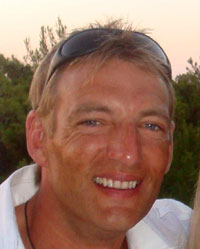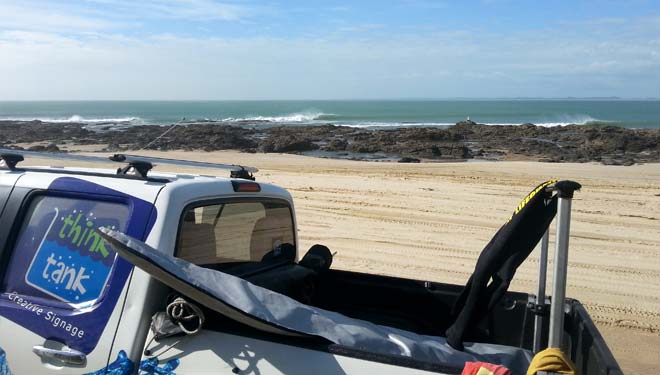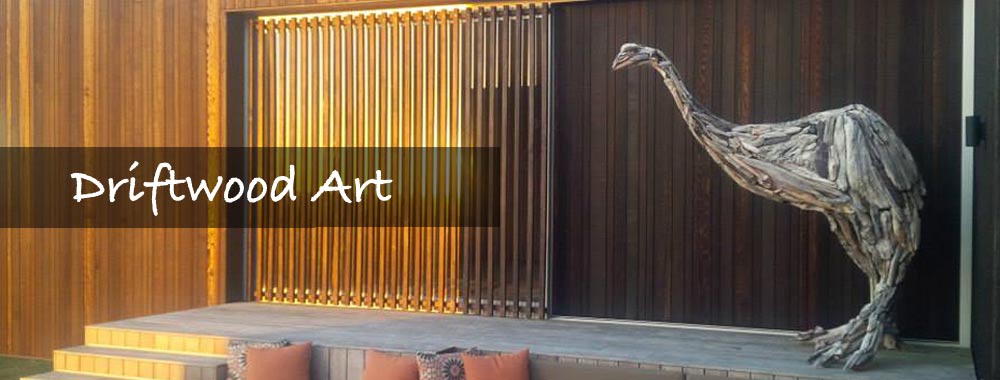Get the inside goss on Greg Maddox, proprietor of Tapatai Driftwood Creations, and all-round creative machine!
Greg Maddox – an interview
 Q. Have you had any formal art training?
Q. Have you had any formal art training?
Greg Maddox: Traditional signwriting apprenticeship of 10,000 hours.
Q. How did you end up being an artist? What do you like/love about being an artist?
Greg Maddox: Using hand rendered and airbrushed graphics through my commercial career was great but the products used to render these are usually quite toxic so working with driftwood sculptures is a much more healthy and eco smart way of creating art that everyone can enjoy.
Q. What career successes (education, exhibitions, collections, etc) are you most proud of?
- The Big Apple campaign in NYC (three giant apple sculptures) and one in the South Street Seaport.
- Working with Grace Graupe Pillard (famous New York Jewish holocaust artist).
- Working with the Auckland Zoo and Matakohe Kauri Museum.
Q. How and why did you start making driftwood sculptures?
Greg Maddox: I’m interested in extinct forms of life and making them tangible again I guess. Sculpture is a much stronger medium than paint has been for me in the past, even though I loved creating murals and airbrushing motorcycles. I love to build things from all forms of wood – be it driftwood or slabs of kauri, both give me immense satisfaction once transformed.
Q. What projects are you working on right now, and why are you enthusiastic about them?
Greg Maddox: I don’t get much of a chance to build my own creations these days through commissions, but when I do get a spare few days soon I’d like to put together a huge fish ball comprising of hundreds of individual fish in the protective spiral/ball they group to form.
Q. How do you decide what to make?
Greg Maddox: If I am to make something for myself, which is rare, I tend to go very large. For example, I have a 4 metre Haast eagle that adorns our property.
Q. What is your favourite piece of equipment, and why?
Greg Maddox: My 18-volt drill! Well, the one I have at the moment anyway as they only seem to last about 3 months these days. I’ve tried just about every brand now, lol.
Q. Give us an idea of how you work on a driftwood piece from start to finish.
Greg Maddox: Unless I’m familiar with an animal I’ll research its form until I’m satisfied I have it in my head. I don’t use working drawings. The sculptures tend to pick how they want to be built. It’s my job to help that process along by keeping flow and personality in the piece.
I don’t like static structure; they must have movement in them in the sense that they are either walking, running, twisting, flying – whatever it takes to grab someone’s attention when looking at it as if maybe it’s looking back at you somehow.
Q. What do you listen to when you create?
Greg Maddox: The good old iPod never seems to fail. I mostly listen to groove/house music, and you can’t beat GeorgeFM for a good play list through the day.
Q. Do you create in any other medium?
Greg Maddox: Yes, I am still a signwriter so there’s still the odd mural to do and hand-rendered signage. I still do the odd painting too, though it’s nowhere near as prolific as Sarah and I used to do since the sculptures became so popular.
Q. How do you spend your time outside of the studio?
Greg Maddox: I’ve been a surf life saver for around 18 years.
Q. What organisations are you associated with and in what ways?
- Surf Life Saving New Zealand – Examiner for IRB driver/crew candidates in the northern region.
- Surf Life Saving Northern Region – Co-ordinating lifeguard SLSBB (Bayly’s Beach, Ripiro)
- Surf Life Saving New Zealand – Water safety co-ordinator for the Paihia ocean swim series.

Q. How does surf lifesaving contribute to your art career or personal development?
Greg Maddox: Hugely for personal development. I can’t say enough how I think surf lifesaving gives back twice fold what someone puts in… it’s really great. And all that time on the beach has it’s benefits for a driftwood sculpturer.
Q. What professional and personal obstacles have you overcome to get where you are today?
Greg Maddox: Moving overseas to Europe was great as the culture was an absolute pleasure to immerse myself into. And I spent many hours in the English Garden in Munich rendering pastels of models from the pension my wife at the time (a model herself) and I stayed in. It was bliss and I was sure this was it for me for the rest of my life (making money as a portrait artist).
But moving to New York City was a whole different ball game. It’s tough to live as an artist in the EU but it’s near impossible in the US, and having to always fall back on my commercial medium was frustrating at times because it wasn’t pure enough for me. But once you accept that it’s okay to do this to survive then doors seem to open up on the creative side of your life… funny how that works.
Q. What essential lessons have you learned from any mistakes?
Greg Maddox: To be patient. Things won’t happen just like that sometimes with sculpture. Step back, have a cuppa and then go back to the piece with slightly fresher eyes. Works every time.
Q. Any tips for new artists?
Greg Maddox: Sometimes people can be very critical of your work but this is not a put down if you use that comment to improve, or even better, to inspire. Nothing great was achieved without a little shove in the right direction, be it accidental or intentional.
Q. What galleries carry your work?
Greg Maddox: Moana Park Vineyard, Matakoe Kauri Museum, South Street Seaport NYC, but mostly private collectors, lots of private collectors.


